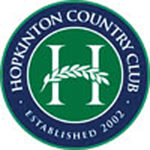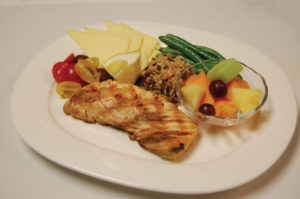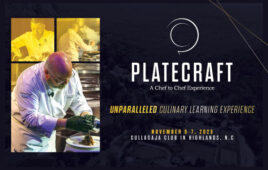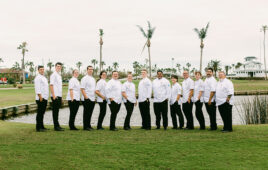Executive Chef Tom Siders has led the development of kids’ culinary camps and other initiatives to introduce healthy eating concepts as a key part of family programming at Hopkinton CC.
The central Massachusetts town of Hopkinton has been known around the world as the starting point of the Boston Marathon for the past 118 years. It is also the home of Hopkinton Country Club, established in 2002 with an 18-hole golf course designed by British architect Ian Scott-Taylor.
Hopkinton CC also has extensive tennis, swimming and fitness facilities. But what really jumps out is the club’s “family programming,” which includes a strong culinary component.
Executive Chef Thomas Siders, who came to Hopkinton in 2006, has been very involved in the development of kids’ camps and other initiatives to introduce healthy eating concepts to members’ children. Chef Tom was nice enough to take time during the start of his season to share some of the ways he’s helped Hopkinton CC establish some of the most successful kids’ activities in the club business.
Q: Chef, your “Kids Camp” program is awesome! Can you run through how it’s been developed and what it now involves?
A: We started the kids’ culinary camps six years ago. The first couple of years were less structured and almost seat-of-the-pants flying. We did not know how popular these camps would become. This year, the culinary camps were the first to sell out.
We do a range of camps encompassing culinary, tennis, golf, swim and all sports. We are contemplating adding another week and have begun a waiting list to see if there will be enough demand. The camps are for kids ages 8-16. After lunch they get to go to the pool for an hour before coming back to finish the day in the kitchen. The camp this year runs from 9 AM-4 PM, with kids being able to go back to the pool afterwards if they cannot be picked up until later in the day.
We are currently running one culinary-cooking camp and one baking-and-pastry camp. The culinary camp starts with the basics: sanitation, knife skills and breakfast cookery. I think it is important that we teach the kids how to use a knife, how to clean up after themselves, and to instill a knowledge of sanitation and cross-contamination.
At the same time we are exposing them to the basics of nutrition. We want to get the kids eating healthier foods and making better choices about what they eat. Each successive day we add additional cuisines: Mexican, Italian, comfort food and healthy cooking.
The baking-and-pastry camp is structured a little differently. We begin with cookies, brownies, cupcakes and basic doughs, then move on to pies, cakes, pate choux and fillings and frostings. Breads, pizza dough and Danish round out the camp, with other items fit in when we have time.
Q: How do you keep the younger students’ attention, and what are some challenges to maintaining what has become a very successful club program?
A: I generally break the campers into two groups, with older and younger children in each group. This allows the older kids to help the younger ones with their tasks. I’m an instructor along with another cook; we work with each group, and I oversee both.
While it’s challenging at times, keeping kids interested is done by simply making it a fun experience and showing them respect. Talk to the kids, and not down to them. Make them feel important and show that you are listening while teaching.
We haven’t gotten to a point yet where you move to a different level when you come back for consecutive years, but we do know who is ready for greater challenges, and we add that to their experience.
Q: What are some of the parents’ comments after they see what their kids can create on their own?
A: At the culinary camp, we cook our lunch and sit down together for a “family meal.” The goal is to get everyone sitting together and eating as a team, and learning to trust and respect each other in camp.
These kids produce enough food to also take some home to share with their families. All of the items are split between the kids and packaged to take with them. The parents’ responses are great. First, they are amazed at what their children are making. And, because all of the campers are given cookbooks that I put together for each camp, the really fun part is hearing back from the parents with stories of the kids using the books at home and how much they begin to participate in their home kitchen.
Some will decide that they enjoy cooking Sunday breakfast, while others want to bake and show off their newfound skills. This year I have some younger siblings joining the camp with their older brothers or sisters, because they too want to learn how to cook.
Overall, this has been a great addition to what we offer at the club. We are a family-based club and are always looking for what else we can do to involve the kids around the club.
Q: You have also extended this “family club” approach through a special children’s menu. How does this work?
A: We developed a menu that reflects the United States Department of Agriculture’s “MyPlate” program and allows children to choose their meals from a list of ingredients and preparation methods. We have a goal of offering quality, healthy and flexible dining to our members, and we think this extends that goal to their children. It also helps parents relax, knowing there are healthy options available for their kids when they eat at the club.
The menu includes five lists, for proteins, vegetables, grains and starches, fruits, and dairy. When ordering, kids choose items from each category, and also choose a preparation: baked, fried, grilled or sautéed in a blend of olive and vegetable oil.
We try very hard to get these ordered similar to how you see them plated. We have given the parents the tools, with the menu, to help guide their children to order correctly and healthily. This does not mean I do not still get orders for chicken tenders, French fries, mac n’ cheese, kid’s pizzas or mashed potatoes. I think we are between 55%-60% of the families who use the menu as it is designed to be used. I may get orders that have two fruits instead of a fruit and a vegetable, but it is in the right direction.
Q: Chef, you are constructing a real kitchen where a basic snack bar existed. Can you run through how you may take advantage of this opportunity?
A: We are looking at what else we need to do to get us to 2020. On the F&B side, we need to tackle our pool offerings. The current kitchen is designed as a snack bar that’s capable of putting out hamburgers, hotdogs, quesadillas, chicken fingers and other snack-type items. We pre-package salads and other items in the main kitchen to give a diversified menu, but it is still limited. We end up with quite a few takeout orders from the main dining room to better serve our members’ needs.
We are just beginning the process of looking at our needs so we can design a kitchen that will better serve our membership. Currently we’re considering two different concepts.
One idea is to extend the current kitchen and build it out with the equipment that would be needed to produce a more expansive and quality-driven menu. The other concept is to create a theme restaurant as an additional outlet. This could be a flatbread, salad and tapas concept, or something more substantial.
Q: Tom, you have most of your culinary staff involved in some kind of continuing education. Can you tell us who goes where, and why?
A: I have been at the Hopkinton Country Club for nine years, and most of my staff has now been with me for seven of those years. One of the challenges of maintaining a long-term staff is keeping them interested and engaged in improving themselves. The investment in our staff helps them to grow while reaping benefits for the club.
With a limited educational budget, you have to be creative. I am going through the ServSafe certification process so I can teach sanitation to all of my staff. I have put all of my cooks, receiving clerks and stewards through ServSafe.
We have begun the process of sending cooks to different courses. Some will attend the Culinary Institute, some will go through some programs at our local community colleges, and I will teach some courses here.
The courses range from Charcuterie to Baking and Pastry. While I can do a course on butchery, or a sauces workshop, or teach dry-cooking techniques, I might send one of my staff to a Nutritional or International cuisine course. If I have two or three cooks who become comfortable with Asian, Indian or Mediterranean Cuisine and Sushi, I can easily do International theme nights or add to the type of stations we can produce.
At the same time I am getting those interested involved in the local ACF chapter and the Epicurean Club of Boston and sending them to some of their events. We will also sponsor certification for those willing to make the effort, and I personally have started redoing my CEC and am tackling the CIA’s Pro Chef Series as well.
Q: Tom, having come from a corporate environment in hotels, you have some great insights about tracking expenses in clubs. Can you share?
 A: I joined Hopkinton Country Club with a background in fine-dining restaurants and hotels. While fully prepared for the cooking and management duties at the club, I was ill-prepared for the club aspect of the business.
A: I joined Hopkinton Country Club with a background in fine-dining restaurants and hotels. While fully prepared for the cooking and management duties at the club, I was ill-prepared for the club aspect of the business.
As a chef, I am well-trained in all types of cuisines and have spent years honing these skills, as all of us chefs do. I knew quite a few club chefs over the years, but never had the opportunity to work in any of their clubs.
Restaurants require you to produce top-quality food in a timely manner, presented well within a certain pricing structure. Hotels add another dimension to this, but operate in similar ways. Both of those businesses rely on a mix of regular and transient customers.
Country clubs are different. You have the same membership that frequents your dining facilities. You do things specifically to make that member feel important, and that is the absolute correct thing to do.
In restaurants and hotels, you diligently track everything that impacts your costs. If food leaves the kitchen without revenue or with discounted revenue, you track it, document it and either charge it to the department that is using it or you critique your food and labor costs accordingly.
When I got here, there was none of this. You just ate everything in your food and labor costs. This is so counterintuitive to how I came up through the industry that I did not know how to deal with it. I proceeded to set up a hotel-style accounting system, only to be told that I could not bill the different departments that incurred the costs and I could not put it in the magical expense column titled “member relations.”
I know that I showed up at my first Chef to Chef Conference, last year in Denver, with one goal in mind: Find out how other clubs handle member related expenses. What food costs are they budgeted to run? And how do they account for this to the club board, GM or Club Manager?
I left last year with no clearer answer, so when I arrived at this year’s Chef to Chef Conference in San Antonio, I began pestering chefs all over again. I learned a great deal about many different clubs, and that the magical “member relations” account is where most clubs and chefs place member-related expenses. I have returned to my club with the mission to get this sorted out and a system in place.
It strikes me as odd, though, that this is not as standardized as it is in hotels. With the Seventh Edition of “Uniform System of Financial Reporting for Clubs” available, you would think that this and member-driven expense issues would be covered in great detail, and there would be a standardized system in place.
Recipe for Tuna Tartare with guacamole and lime-ginger vinaigrette
Recipe for Ginger-Seared Scallops
Recipe for Chicken Enchiladas
Recipe for Apple Strudel and Filling
Recipe for Strudel Dough
Recipe for Raisin Bread and Filling
Recipe for Raisin Bread Dough
Hopkinton CC’s children’s menu








